Diseases and pests on cauliflower and methods of combating them
Cauliflower is difficult to grow: it is sensitive to changes in temperature, demanding on the composition of the soil and light-loving. It’s a shame if your work turns out to be in vain due to a plant disease or insect attack. Vegetable growers successfully cope with most infections and dangerous pests by taking timely measures, but some problems have specific features.
Cauliflower diseases
Cauliflower is bred through selective breeding and is not found in the wild, so it is not surprising that it is highly susceptible to various diseases. The crop reacts negatively to even minor changes in the soil and does not tolerate waterlogging and violation of care rules.
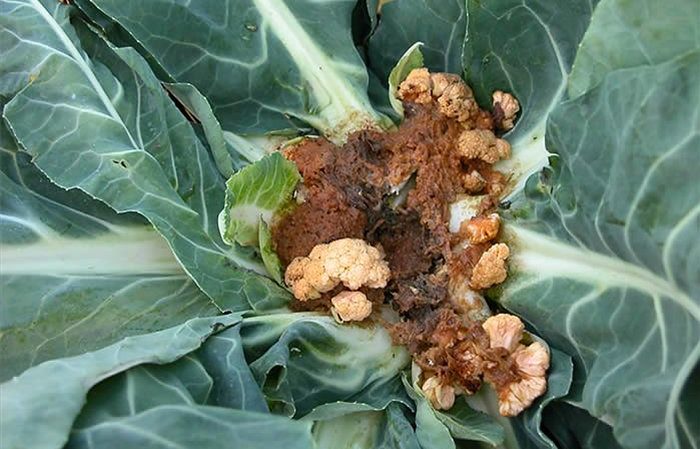
White rot similar to mold
White rot is a fungal disease that occurs on already harvested crops when storage conditions are violated, in particular when humidity levels are above 80%. It's difficult to notice. White web-like formations with rare black dots appear on the surface of the inflorescences, similar in appearance to mold, and the stem and leaves are covered with mucous secretions.
Control and prevention measures:
- before planting cabbage lime the soil;
- spray plants with copper preparations during the growth period;
- treat the premises for storing crops with a solution of potassium permanganate;
- carefully inspect vegetables before storing them and remove affected specimens;
- observe the recommended humidity (up to 80%) and air temperature (up to +1°C).
It is prohibited to eat such cabbage. Affected heads are immediately discarded.
Gray rot
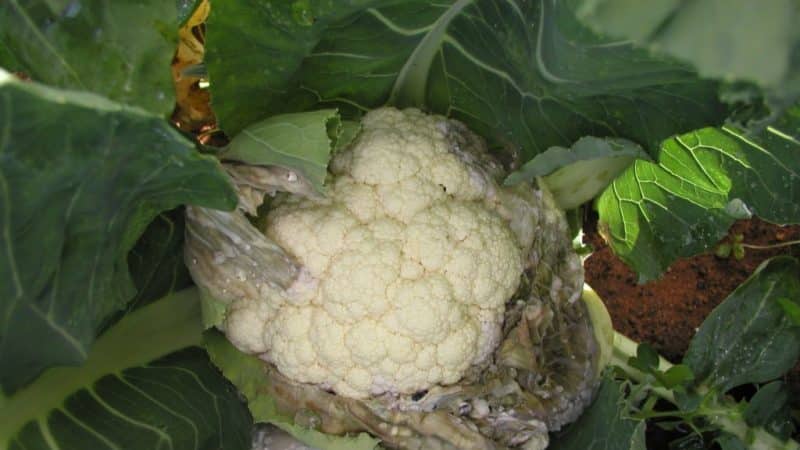
The manifestation of this disease is noticeable already during storage of the harvested crop. First, gray spots appear on the inflorescences, the process of decay begins, mucus appears on the damaged surface and a cotton-like fluff forms.
Measures to prevent cabbage from becoming infected with gray rot:
- disinfect the room and container in which the crop will be stored with a solution of potassium permanganate;
- normalize the temperature (up to +1°C).
The main cause of this disease is wet and cold weather.
Kila
This is one of the most dangerous diseases for cauliflower. The causative agent is a microscopic fungus that causes deep damage to the root system. As a result, nodular formations appear in this part of the plant, metabolism is disrupted, growth slows down and the crop dies.
To prevent the spread of disease:
- Infected heads of cabbage are completely removed from the area;
- the soil is irrigated with a solution of fungicide or Bordeaux mixture;
- Weeding is carried out regularly.
If the land plot has been infected, cauliflower should be planted on it no earlier than after 5 years.
Mosaic virus

The mosaic virus spreads by transferring the sap of infected plants. A vegetable pest, aphids, is involved in this. Infection of seedlings is indicated by their stunted growth and yellowing of the stems. The leaves become spotted and fall off.
Steps to prevent the spread of the virus:
- Before planting, the seed is disinfected by soaking it for 20 minutes in hot water (up to +50°C) and drying it afterwards;
- monitor the temperature regime for seedlings (not higher than +20°C);
- affected specimens are dug out of the soil, trying not to damage the root system, and disposed of;
- observe the recommended humidity (up to 80%) and air temperature (up to +1°C);
- Weeding is carried out systematically.
The development of the disease is provoked by oversaturation of the soil with nitrogen-containing fertilizers.
Mucous and vascular bacteriosis
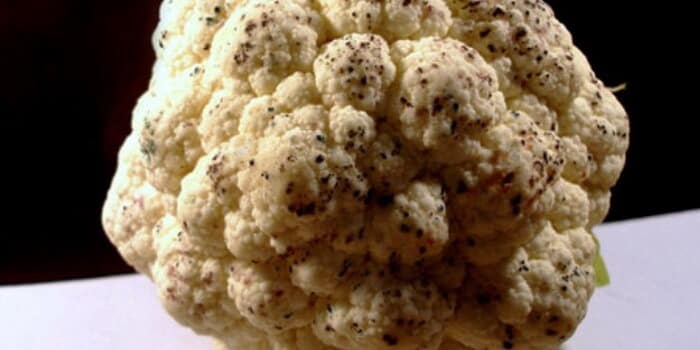
Mucous bacteriosis is one of the most common diseases of cauliflower. It directly affects the inflorescences and manifests itself in the form of focal rotting of leaves, which move to the head of cabbage, provoking the appearance of black spots and a putrid odor.
The problem is solved as follows:
- weed the beds regularly;
- the soil is not waterlogged;
- fight vegetable pests;
- disinfect pantries.
No less common is vascular bacteriosis, which manifests itself at absolutely all stages of culture development. It causes significant damage to the crop. External manifestations of infection of the cabbage vascular system look like this: the appearance of yellow dots along the edges of the tops, their growth towards the center, and blackening of the veins. As a result, the leaves wither and crumble.
Reference. The causative agents of the disease (bacteria) are spread by cabbage flies, slugs, and bedbugs; they are transported with raindrops, stored in plant debris and in seeds for up to 3 years.
There are no effective methods to combat infection, so preventive measures are followed:
- the area from which the infected vegetables were removed is treated with a solution of colloidal sulfur (concentration - 0.4%);
- next time cauliflower is planted no earlier than after 3 years;
- the seed is soaked in the Agata-25 solution in accordance with the instructions.
Favorable weather conditions for the development of vascular bacteriosis are warm autumn with high air humidity.
Fusarium
This fungal disease is incurable, since spores that enter the soil remain active for a long time. External manifestations of infection: yellowing of the leaves is gradually supplemented by brown or brown spots, which grow over the entire area. As a result, the leaves fall off.
Prevention measures:
- affected vegetables are disposed of;
- the soil is irrigated with a solution of copper sulfate;
- follow the rules of crop rotation.
Chlamydiospores of the pathogenic fungus persist in the soil for up to 11 years. Their activation is facilitated by dry and hot weather at the beginning of the crop's growing season.
Blackleg
Blackleg, or rhizoctonia, poses a direct threat to young plants and seedlings. The stem of an infected seedling becomes covered with black spots, becomes thinner and dies. Other vegetable crops are also susceptible to this disease: sweet peppers, tomatoes, eggplants, radishes, lettuce, potatoes. Therefore, cauliflower infected with black leg poses a direct threat to neighboring beds.
Measures to combat blackleg:
- treating beds with fungicide;
- preliminary soaking of the seed in a solution of potassium permanganate and pouring it into the holes after removing diseased seedlings;
- avoiding dense plantings;
- liming of soil.
The development of the disease is facilitated by growing cabbage in acidic soil, excessive moisture, lack of ventilation and dense planting.
Downy mildew
Another fungal disease of cauliflower manifests itself in the formation of a whitish coating and yellow spots on the foliage. The disease affects the seeds and stems, causing black and brown lesions to appear on them.Downy mildew significantly slows down crop growth.
They fight peronosporosis with the following methods:
- after harvesting, all crop residues and weeds are carefully removed from the beds;
- they dig up the ground;
- before planting young plants, the soil is irrigated with a fungicide solution;
- seed material is placed in hot water (no more than +50°C) for 20 minutes and in cold water for 3;
- when the first signs of the disease are detected, the seedlings are sprayed three times with a solution of ground sulfur;
- affected plants are destroyed.
If the disease has not affected the inflorescences, such a product is allowed to be eaten.
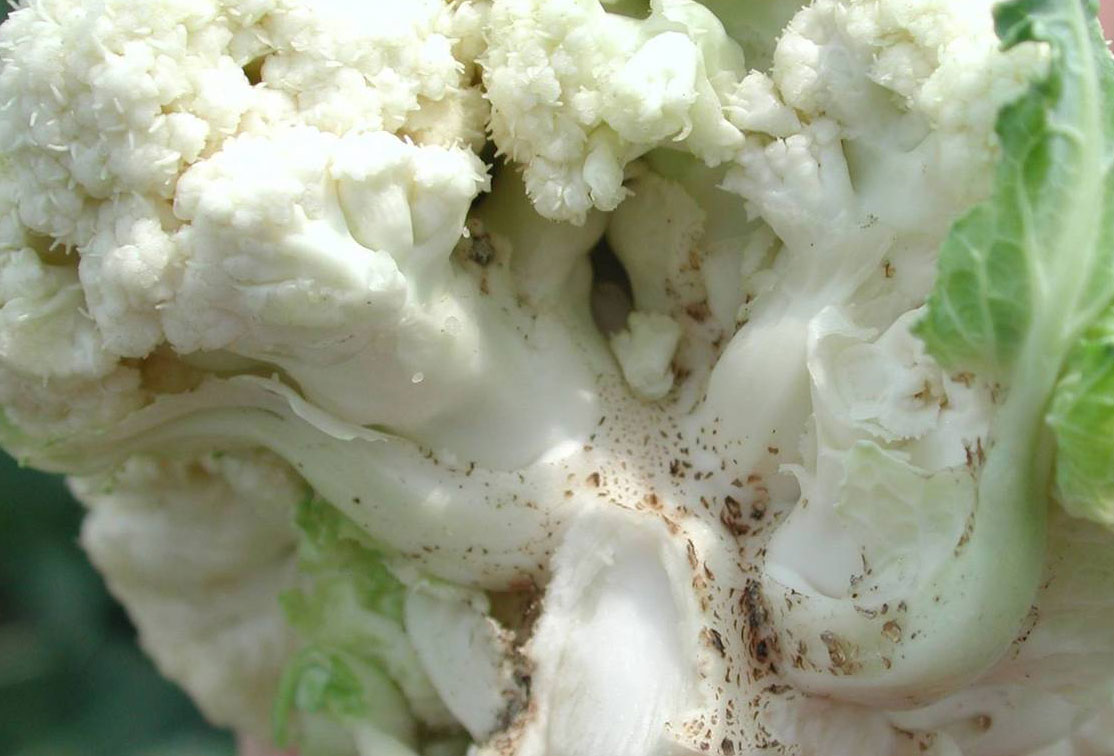
Pests on cauliflower
Not only diseases harm cauliflower in a summer cottage. Various insect pests pose no less danger to it. Some of them can only be detected after they have caused significant damage to the crop.
Cabbage aphid
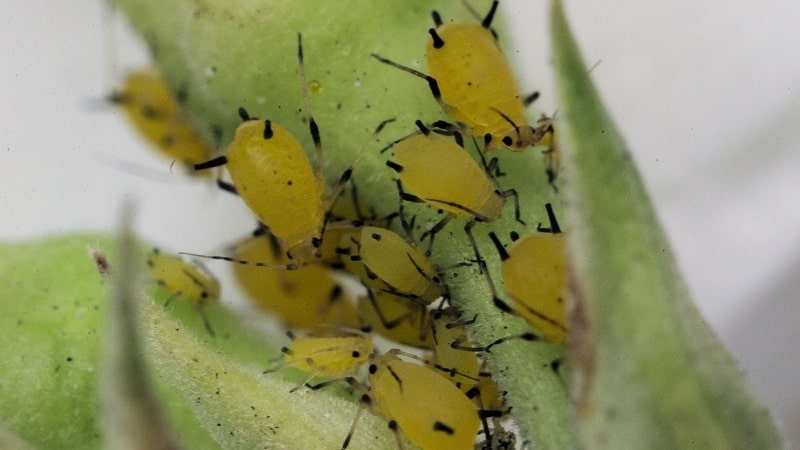
This pest is found in many areas. Cabbage aphids multiply rapidly, feed on plant sap, causing irreparable damage to cauliflower, the foliage of which becomes covered with a pink coating and curls.
Fighting aphids:
- treating the affected crop with a soap solution;
- use of insecticides;
- clearing the area of weeds;
- digging up beds before transferring seedlings into open ground.
Caterpillars

Caterpillars are one of the developmental stages of white butterflies or moths. Insects lay eggs on the leaves of the vegetable, and the hatched larvae actively destroy them. If at first they eat only leaves, then as they grow older they get to the inflorescences.
To ensure successful control of caterpillars, adhere to the following rules for caring for cauliflower:
- systematically inspect the crop for the presence of pests;
- collect and destroy insect eggs and caterpillars themselves;
- treat vegetables with low-toxic insecticides.
Spraying the inflorescences should not be neglected. Some caterpillars get into them so deeply that manual collection is ineffective.
This is interesting:
Is there an allergy to cauliflower in infants?
Purple cauliflower: description and photo
Cauliflower does not set in open ground: why does this happen and what to do
Cabbage flies

This insect lays eggs in the soil around the plant and on its stem. As the larvae grow, they destroy not only the cauliflower itself, but also the surrounding crops.
Measures to combat cabbage flies:
- regularly dig up the soil;
- Hill up the heads of cabbage at least once a month;
- sprinkle the inflorescences with wood ash;
- treat plantings with insecticides.
Cruciferous flea beetles
These insects are most often found on young plants, preferring to feed on cabbage leaves. Small black bugs actively gnaw through the tops, creating many holes, which leads to its death. Pests can quickly destroy all planting material.
How to stop a cruciferous flea beetle infestation:
- systematically dig up the soil;
- weeds are carefully pulled out;
- cover plants in hot weather with dense material;
For prevention, plants are planted around cabbage whose aroma the pest cannot tolerate. These include tomatoes, marigolds, tansy, coriander, garlic, dill, caraway, calendula and wormwood.
Slugs
Slugs are not a big problem for cauliflower. Although they are found on almost every plant, they do not cause significant harm to the crop. These snail-like mollusks feed on plant juices, gnawing on their stems, leaves and fruits.In cauliflower, usually only the lower part is affected.
Important! There are no specific means of combating slugs, and it is best to remove them manually.
Since these pests prefer moist soils, maintaining a watering regime without excessive moisture and stagnation of liquid will prevent their occurrence.

Conclusion
Since it is difficult to combat diseases and pests of cauliflower, it is important to direct the main efforts to preventive measures. The use of pesticides in this regard is not always justified, so traditional methods and adherence to growing rules will help cope with most problems. Another mandatory action is disinfection of the beds after harvesting.